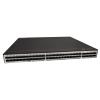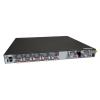-
zł


The Huawei S6750-H48Y8C is a high-performance, manageable switch equipped with 48 SFP28 slots (1 / 10 / 25 Gbps) and 8 QSFP28 slots (40 / 100 Gbps). It stands out for its advanced Layer 3 management and very high throughput. The total switching capacity is 4 Tbps. The device enables user authentication in the network, both wired and wireless, using various methods such as 802.1x and MAC addresses (requires an N1 Foundation license). It provides highly efficient QoS functionality and fast, effective management. It supports RIP, IS-IS, and BGP routing, as well as their IPv6 counterparts. The S6750-H48Y8C supports iStack, allowing it to be combined in a virtual stack with other switches, simplifying network management and improving stability with redundant connections. The offered product comes with one AC power supply, one DC power supply, and an N1 Basic license.
N1 Foundation - Network automation based on iMater NCE-Campus
N1 Advanced - Includes everything from N1 Foundation plus VXLAN functions, Free Mobility, IPCA, and CampusInsight features.
Specifications
| Huawei S6750-H48Y8C AC+DC | |
| Fixed ports |
48x SFP28 (1 / 10 / 25 Gb/s) 8x QSFP28 (40 / 100 Gb/s) |
| Dimensions (H x W x D) | 43.6 mm x 442.0 mm x 420.0 mm (1.72 in. x 17.4 in. x 16.54 in.) |
| Chassis weight (including packaging) | 11,23 kg |
| Chassis height(U) | 1U |
| Power supply type |
AC DC |
| Rated voltage range |
100 - 240 V AC, 50/60 Hz -48 V DC ~ -60 V DC |
| Maximum voltage range |
90 - 290 V AC, 45-65 Hz -38,4 V DC ~ -72 V DC |
| Typical power consumption (30% of traffic load, tested according to ATIS standard) | 223 W |
| Maximum power consumption (100% throughput, full speed of fans) |
244 W High temperature 45°C (113°F), 100% traffic, and dual power modules: 342 W |
| Noise at normal temperature (acoustic power) |
58.4dB (A) |
| Noise under high temperature (sound power) |
82.1dB (A) |
| Noise at normal temperature (acoustic pressure) |
57.2dB (A) |
| Operating temperature | -5°C to +45°C (23°F to 113°F) |
| Storage temperature | -40°C to +70°C (-40°F to +158°F) |
| Relative humidity | 5% to 95%, noncondensing |
| Power supply surge protection | Using AC power modules: ±6 kV in differential mode, ±6 kV in common mode Using DC power modules: ±2 kV in differential mode, ±4 kV in common mode |
| Heat dissipation | Air cooling for heat dissipation, intelligent fan speed adjustment |
| Service Features | |
|---|---|
| User management | Unified user management 802.1X authentication MAC authentication Traffic- and duration-based accounting User authorization based on user groups, domains, and time ranges |
| MAC | Automatic MAC address learning and aging 512K MAC entries (MAX) Static, dynamic, and blackhole MAC address entries Source MAC address filtering MAC address learning limiting based on ports and VLANs |
| VLAN | 4K VLANs Access mode, Trunk mode and Hybrid mode Default VLAN QinQ and enhanced selective QinQ VLAN Stacking, VLAN mapping Dynamic VLAN assignment based on MAC addresses |
| ARP | ARP Snooping |
| DHCP | DHCPv4 Client/Relay/Server, DHCPv4 Snooping DHCPv6 Client/Relay/Server, DHCPv6 Snooping |
| IP routing | IPv4 dynamic routing protocols such as RIP, OSPF, IS-IS, and BGP IPv6 dynamic routing protocols such as RIPng, OSPFv3, ISISv6, and BGP4+ Routing Policy, Policy-Based Routing VRF |
| Segment Routing | SRv6 BE (L3 EVPN) BGP EVPN SRv6 configuration through NETCONF |
| Multicast | IGMPv1/v2/v3 and IGMP v1/v2/v3 Snooping PIM-DM, PIM-SM, PIM-SSM, PIMv6 Fast-leave mechanism Multicast traffic control Multicast querier Multicast protocol packet suppression |
| MPLS |
MPLS-LDP MPSL-L2VPN MPLS QoS |
| VXLAN |
Centralized gateway Distributed gateway BGP-EVPN Configures VXLANs through NETCONF |
| QoS | Traffic classification based on Layer 2 headers, Layer 3 protocols, Layer 4 protocols, and 802.1p priority Actions such as ACL, Committed Access Rate (CAR), re-marking, and scheduling Queuing algorithms, such as PQ, DRR, WDRR, and PQ+DRR, PQ+WDRR Congestion avoidance mechanisms such as WRED and tail drop Traffic shaping Eight queues on each interface Network Slicing |
| Native-IP IFIT | Marks the real service packets to obtain real-time count of dropped packets and packet loss ratio The statistical period can be modified Two-way frame delay measurement |
| Ethernet loop protection | STP (IEEE 802.1d), RSTP (IEEE 802.1w), and MSTP (IEEE 802.1s). BPDU protection, root protection, and loop protection G.8032 Ethernet Ring Protection Switching (ERPS) Smart Ethernet Protection(SEP) |
| Reliability | M-LAG Service interface-based stacking Maximum number of stacked devices Stack bandwidth (Bidirectional) Link Aggregation Control Protocol (LACP) and E-Trunk Virtual Router Redundancy Protocol (VRRP) and Bidirectional Forwarding Detection (BFD) for VRRP BFD for BGP/IS-IS/OSPF/static routes Eth-OAM 802.1ag(CFM) Smartlink LLDP LBDT Y.1731 |
| System management | iStack, Maximum number: 9 Console terminal service Telnet/IPv6 Telnet terminal service SSH v1.5 SSH v2.0 SNMP v1/v2c/v3 FTP? TFTP? SFTP BootROM upgrade and remote in-service upgrade Hot patch User operation logs Open Programmability System (OPS) Streaming Telemetry GVRP iPCA, NetStream, NQA, Telemetry |
| Security and managemen | NAC RADIUS and HWTACACS authentication for login users MACsec Command line authority control based on user levels, preventing unauthorized users from using command configurations Defense against DoS attacks, Transmission Control Protocol (TCP) SYN Flood attacks, User Datagram Protocol (UDP) Flood attacks, broadcast storms, and heavy traffic attacks IPv6 RA Guard CPU hardware queues to implement hierarchical scheduling and protection for protocol packets on the control plane Remote Network Monitoring (RMON) Secure boot Port mirroring ND snooping |






 Polski
Polski English
English Italiano
Italiano Español
Español Čeština
Čeština Српски
Српски Deutsch
Deutsch Ελληνικά
Ελληνικά Slovenský
Slovenský




